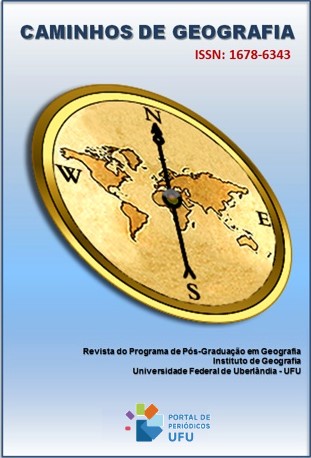VARIAÇÕES SAZONAIS DO ÍNDICE DE TEMPERATURA EFETIVA (ITE) E ÍNDICE DE CALOR (IC) COM O USO DO SOLO EM ZONA URBANA NA AMAZÔNIA ORIENTAL
DOI:
https://doi.org/10.14393/RCG249365649Palavras-chave:
Vegetação, Urbanização, Conforto térmico, MacapáResumo
Recentes estudos na Amazônia demonstram que a urbanização é o fator mais impactante dos padrões microclimáticos, contrastando com a redução da cobertura vegetal, o elemento mais relevante para a manutenção do conforto térmico. O objetivo da investigação é analisar a variação do índice de conforto térmico na cidade de Macapá-AP sob influência do uso e ocupação do solo, especialmente em relação à redução da cobertura vegetal. A metodologia de investigação consistiu na análise do índice de temperatura efetiva e Índice de calor como fatores preditivos do conforto térmico durante três períodos sazonais distintos: chuvoso (abril/2018), seca (novembro/2018) e de transição (junho/2019). Com esse propósito foram escolhidos estrategicamente cinco sítios urbanos geográfica e criteriosamente distribuídos ao longo dos eixos Nordeste-Sudoeste e Oeste-Leste da cidade, usando a técnica de classificação supervisionada e monitoramento de séries temporais da temperatura média e umidade relativa do ar. Os resultados sugerem que as áreas mais vegetadas evitam a extrapolação dos limites dos índices de conforto térmico (p<0,05), ratificando resultados similares da literatura registrados em outras cidades amazônicas. Assim, o Índice de Temperatura Efetiva variou entre confortável e desconfortável e o Índice de Calor variou entre confortável e cautela, apresentando amplitude espaço-sazonal térmica considerável.
Downloads
Downloads
Publicado
Edição
Seção
Licença
Copyright (c) 2023 Pedro Hugo Oliveira Moreira, Antonio Carlos Lola da Costa, João de Athaydes Silva Júnior, Alan Cavalcanti da Cunha

Este trabalho está licenciado sob uma licença Creative Commons Attribution-NonCommercial-NoDerivatives 4.0 International License.
Autores que publicam nesta revista concordam com os seguintes termos: a) Autores mantém os direitos autorais e concedem à revista o direito de primeira publicação, com o trabalho licenciado sob a Creative Commons Atribuição-NãoComercial-SemDerivações 4.0 Internacional. b) Autores têm permissão e são estimulados a publicar e distribuir seu trabalho online (ex.: em repositórios institucionais ou na sua página pessoal), já que isso pode gerar alterações produtivas, bem como aumentar o impacto e a citação do trabalho publicado. c) Em virtude de aparecerem nesta revista de acesso público, os artigos são de uso gratuito, com atribuições próprias, em aplicações educacionais e não-comerciais.











